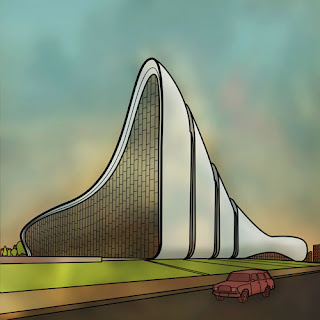There have been various tributes to Zaha Hadid over the past year and now it's my turn to contribute. Being a bit of a perfectionist, I accept an architect's portfolio can vary in quality over time. However, I didn't have any problem picking out four of my favourites for this piece, leaving Wangjing SOHO and her work for The London Science Museum's Architects' Mathematics project as close runners up for inclusion. Hopefully this piece strikes a loud celebratory tone, even if I can't help but mention some of the buildings' neglected details. What I really want to throw a party for is Hadid herself. She has an amazing story and I really admire her tenacity to build. It's definitely something I can identify with. Her extraction from the Middle East and representation of that culture in modern architecture has improved our cities immensely. She had the honour of being the first woman to win the Pritzker Prize in 2004. I will end by saying if you enjoyed the post, please consider sharing it with at least one friend that needs a smile.
A small problem about this building cropped up in the preparation for this post: It looks good from every angle. This fact made it difficult to pick a favourite perspective. Once in view, it's a hard building to take one's eyes off of. Hadid really seems at her most inspired here. The interior is a bit strange, with the main entrance foyer in pure white. I know it's to accentuate the forms but the atmosphere has always struck me as a bit sterile. I've never heard any reports back as to the auditorium's acoustic performance but I imagine its relative remoteness plays a factor in that. Returning to the exterior, it will be interesting to see how the future treats the glass finishing, the main building tiles using a glass-reinforced polymer and the plaza a glass-reinforced concrete.
The Jockey Club Innovation Center, Hong Kong Polytechnic University, 2014.
This building in particular does such a good job channelling the futuristic style of Japanese science-fiction anime. I don't know if that's what Hadid was aiming for when she designed this building, but overall, the building's stance does an excellent job communicating its forward-thinking purpose; the perfect message for a university. Many buildings in our communities don't stray far from the traditional rectilinear form and wear their value engineering as an aesthetic. I really applaud the clients for their open mindedness in this project. The way the facade twists and wraps around the exterior adds a lot of visual interest to the building.
Library and Learning Centre University of Economics, Vienna, 2013
This building is also really interesting from the air but I liked this view of the main entrance better. The interior, for the most part, sticks to all white again but I think the spaces are much better handled in this project and don't seem so sterile or monolithic as the Heydar Aliyev Center above. Here I think the comparison to postmodern Japanese architecture is also apt because that is a category of architecture which also highlights the sophisticated possibilities of pure white interiors.
Investcorp building, Oxford, 2015.
I wanted to include this smaller project from her studio because it showcases her excellent conception of novel interior spaces and approach to matching modern architecture to traditional settings. Sometimes whacky curvilinear rooms never really work functionally but much of Hadid's work pulls off this difficult balancing act between form and function. The interior views of this building confirm how much planning and effort went into designing these spaces. The exterior is where I see the most Middle Eastern influence but have been struggling to find the words to express it. Housing some of the facilities for Oxford's School of Middle Eastern studies, I imagine this project was meaningful to Hadid. It's parametric roots are obvious but somehow it's proportions exemplify the dignity of the region that couldn't be accomplished by a Japanese of North American architect. That said, perhaps others will see this building distinctly in the modern international style that could be placed anywhere.





No comments:
Post a Comment